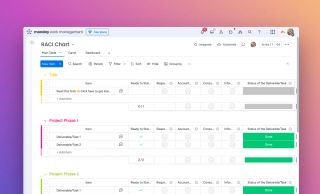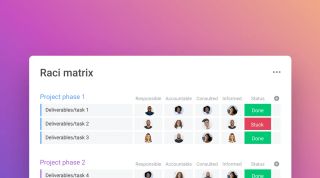A RACI matrix is a simple tool used in project management to define roles and responsibilities clearly. It eliminates confusion by assigning specific roles to tasks:
- Responsible (R): The person(s) doing the work.
- Accountable (A): The one with final decision-making authority.
- Consulted (C): Experts providing input.
- Informed (I): Those updated on progress.
Why use a RACI matrix?
- Clarifies who does what, avoiding delays or duplicated efforts.
- Improves communication by defining who to contact for approvals or updates.
- Ensures no tasks are missed, helping balance workloads.
How to create one:
- Identify stakeholders (e.g., project managers, developers, business users).
- Break the project into tasks (e.g., planning, design, implementation).
- Assign RACI roles for each task.
Using tools like monday.com can simplify the process by automating notifications and tracking responsibilities. Regular updates keep the matrix relevant and effective. Using monday work management from monday.com, you can simply use the prebuilt RACI chart template.

Key takeaway: A RACI matrix ensures smooth collaboration by defining clear roles, improving communication, and covering all tasks in a project.
Benefits of a RACI matrix for integration projects
Clear role definition
A RACI matrix eliminates confusion in integration projects by defining who is responsible for each task and decision. This prevents disputes, delays, and wasted resources.
For example, when working with platforms like monday.com, the matrix ensures tasks are assigned transparently. This clarifies roles and supports smoother team communication.
Improved team communication
By setting clear expectations, a RACI matrix makes collaboration more effective. Everyone knows who to contact for specific tasks, reducing delays.
Here’s how it helps:
- Accountable roles get targeted information for quick approvals.
- Responsible roles receive timely expert input.
- Informed roles stay updated without being overwhelmed.
- Consulted roles provide expertise at the right moments.
Comprehensive task coverage
A RACI matrix ensures no tasks are overlooked by explicitly assigning roles. Key benefits include:
- Preventing critical tasks from being missed.
- Highlighting resource gaps or overloads.
- Balancing workloads effectively.
| Task coverage element | Impact of RACI matrix |
|---|---|
| Task ownership | Defines who leads each activity |
| Resource allocation | Identifies shortages or excesses |
| Decision authority | Clarifies who makes final calls |
| Stakeholder involvement | Specifies engagement levels |
Creating your RACI matrix
Map project stakeholders
Identify everyone involved in your integration project, such as:
- Project sponsor: Ensures the project’s success.
- Technical lead: Oversees implementation.
- Platform administrators: Handle configurations.
- End users: Team members using the integrated systems.
- Department heads: Provide requirements and approvals.
Document each stakeholder’s role and expertise to guide RACI assignments.
Document project tasks
Divide the project into phases and tasks:
| Project phase | Task examples | Deliverables |
|---|---|---|
| Planning | Requirements gathering | Project charter |
| Design | Architecture planning | Technical specs |
| Implementation | Platform configuration | Test results |
| Deployment | User training | Support documentation |
David Simpson Apps provides sophisticated file & document management automations to make monday.com and SharePoint work seamlessly together. Folders and files containing your project documentation in SharePoint can easily be linked to your RACI matrix in monday.com.
Define RACI roles
Assign roles for each task:
- Responsible (R): Team members with the right skills.
- Accountable (A): One person overseeing completion (often a project manager).
- Consulted (C): Experts providing input.
- Informed (I): Stakeholders needing updates.
Use tools like monday.com to automate role assignments and notifications.
Enhance your workflows with David Simpson Apps
Discover powerful apps and integrations for monday.com, Atlassian, and Microsoft 365. Streamline processes, embed analytics, and boost collaboration.
Explore appsRACI matrix implementation tips
Get team agreement
Host a workshop to review RACI roles and secure written approval. Keep sessions short (30 minutes) to maintain engagement.
Connect with project tools
Link your RACI matrix to tools like monday.com to:
- Automatically notify stakeholders.
- Monitor task progress.
- Create role-based dashboards.
- Sync updates across platforms.
Keep the matrix updated
| Review type | Frequency | Focus areas |
|---|---|---|
| Quick check | Weekly | Task assignments |
| Deep review | Monthly | Role effectiveness |
| Full audit | Quarterly | Strategic alignment |
Use surveys and completion rates to evaluate the matrix. Update it promptly when changes occur.
RACI matrix: 4 rules you have to follow
Conclusion
The RACI matrix ensures clear role assignments and communication, crucial for integration projects. Structured project management delivers measurable ROI, with 61% of Fortune 500 companies relying on such practices.
By integrating the matrix with tools like monday.com, teams reduce administrative burdens and focus on results.
FAQs
What challenges do teams face with RACI matrices?
Common issues include role ambiguity and overcomplication. Address these by:
- Clearly defining roles upfront.
- Keeping the matrix simple.
- Communicating its benefits to resistant team members.
How often should a RACI matrix be updated?
Review it at key milestones or quarterly for long projects. Update immediately after team or scope changes to maintain clarity.
What alternatives to & evolutions of RACI are popular?
While RACI is popular, some teams use variants such as:
- DACI (Driver, Approver, Contributor, Informed) – More decision-focused.
- PARIS (Participant, Accountable, Reviewer, Informed, Signatory) – Adds approval layers.
- RASCI – Adds "Support" role for helpers.
How can I use a RACI matrix with tools like monday.com?
Integrate it by setting up columns for R/A/C/I roles. Use custom fields to visualize responsibilities and automate notifications for updates.
→ Use the monday.com template center to add the RACI matrix template.
→ Install Microsoft 365 SharePoint • Automate & Embed from the monday.com marketplace
Automate your workflows with David Simpson Apps
Discover powerful apps and integrations for monday.com, Microsoft 365 and more. Streamline processes, embed analytics, and boost collaboration.
View our apps on the monday marketplace




